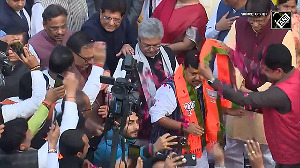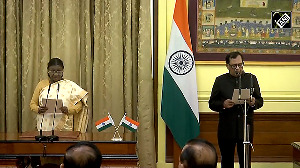
With big data analyses, your investments, spends and big purchases are being tracked more closely now by the income tax department, warns Tinesh Bhasin.
Illustration: Uttam Ghosh/Rediff.com
With sophisticated technology now at their disposal, the tax authorities are trying to be one step ahead of evaders.
The income tax (I-T) department always had information at its disposal, using which it sent out notices to taxpayers. But most of these were looked at in silos.
They are now using technology like big data analytics to combine all the information and get a 360 degree income profile.
Earlier, if you purchased a house that didn't match the returns filed, they would call for you to explain how you funded it.
All you had to do then was show the assessing officer loan documents and statement of savings.
The same verification is now done with a deeper understanding of your income profile.
Now, the officer can look at your purchases and spending -- like a car, gold or credit card bills -- and check if the savings you showed are justified or not.
The deposits made during demonetisation is only the starting point for investigations.
"The tax authorities are armed with a large amount of data. They are tracking investments, property buying, high-value purchases and spends on credit cards," says Shailesh Kumar, director, direct taxation, Nangia & Co.
All the information gathered is mapped to a person's Permanent Account Number, PAN.
If you bought a property, the information is linked to your PAN. So are details of high spends and investment.
The data is collated, mined and analytics is used to track possible evasion.
It can be as simple as finding the total deposits a person has made in several bank accounts to estimating the income mismatch by analysing tax returns, deposits, investments and spends.
Last year, the finance ministry launched Project Insight. The implementation has started and will be completed by 2018.
It is a technology platform that uses information to catch evaders, promote voluntary compliance and deter non-compliance.
Explains Chetan Chandak, head, tax research, H&R Block India: "The project has two modules -- Income Tax Transaction Analysis Centre (INTRAC) and Compliance Management Central Processing Centre (CMCPC)."
INTRAC uses technologies such as data integration, data processing, data quality monitoring, data analytics. They show discrepancies in income.
If you purchased a property worth Rs 1 crore, but have showed income of Rs 5 lakh in your returns, an alert is generated for further investigations.
INTRAC will also mine the Web and social media to pick information about a person.
If you post about a luxury trip and don't file income tax returns, expect a letter from authorities seeking details of your income.
Experts say it won't be surprising if the tax department has created income models for individuals and businesses, like credit bureaus do.
If a person does not have a credit history, the credit bureaus look at similar profiles of borrowers and predict the income a new borrower could have.
Then, they match the declared income with their prediction to check deviations, helping banks to assess the borrower better.
CMCPC handles preliminary verification, generates bulk letters or notices and follow-up on these.
In Operation Clean Money, the notices are sent by the CMCPC automatically, without human intervention.
The replies an assessee will provide for the notices, too, will get fed in the system automatically and analysed, based on which further investigations will happen.
Automation of notices means taxpayers don't need to go to an assessing officer to provide relevant evidence.
It has also reduced the workload of tax officers, who are now focusing on areas where revenue leakages are higher, according to experts.
The finance ministry has maintained secrecy around Project Insight. It's done to avoid leakage on its functioning.
When the ministry floated tenders for the programme, all information technology companies bidding for it were made to sign a non-disclosure agreement.
With a substantial portion of the Rs 15.4 lakh crore of cancelled Rs 500 and Rs 1,000 notes coming back into the system, the tax department suspects that evaders legalised their money using mules and proxies.
Many business owners have used back-dated bills to justify the cash.
But evaders weren't only depositing cash by using various methods; they were also providing data to the authorities.
As the money came into banking channels, it can be tracked easily.
The details are now being used to catch such evaders and experts feel it's tough to escape the department.
During demonetisation, deposits between Rs 2 lakh and Rs 80 lakh were made in about 10.9 million accounts, with an average deposit size of Rs 5.03 lakh.
Deposits of more than Rs 80 lakh were made in 148,000 accounts, with average deposit size of Rs 3.31 crore.











